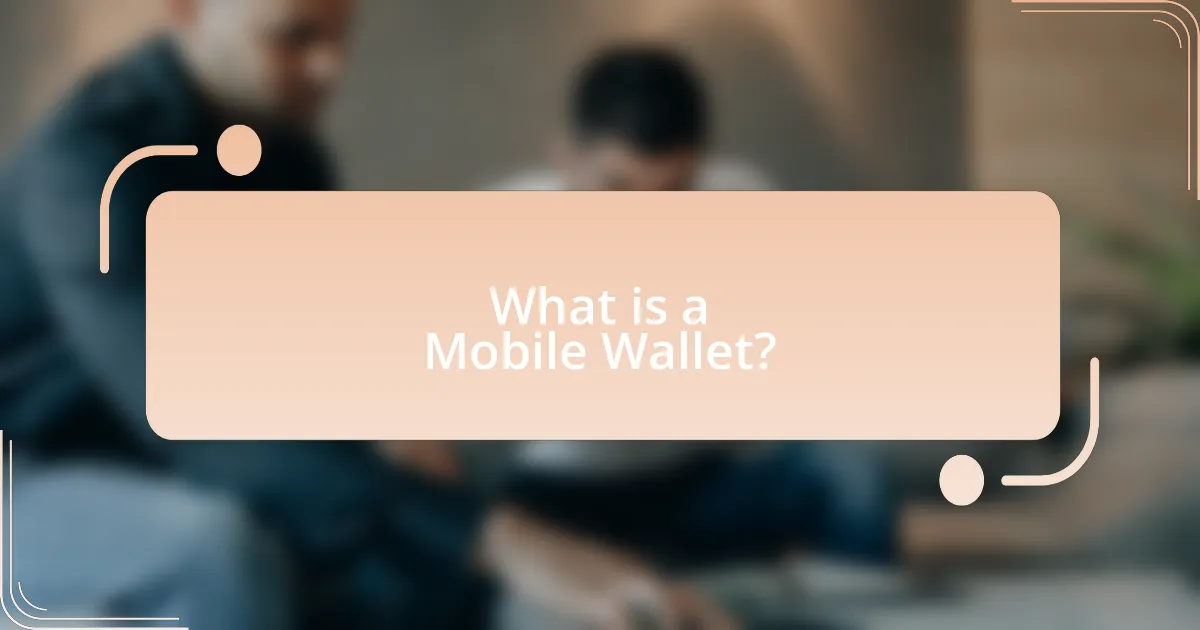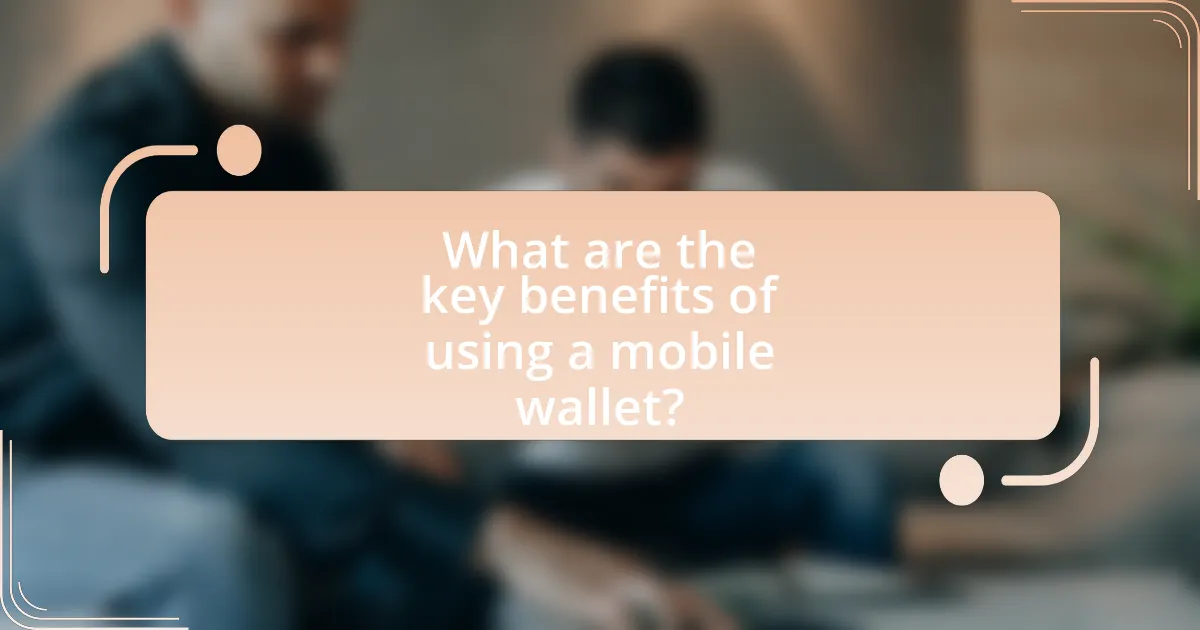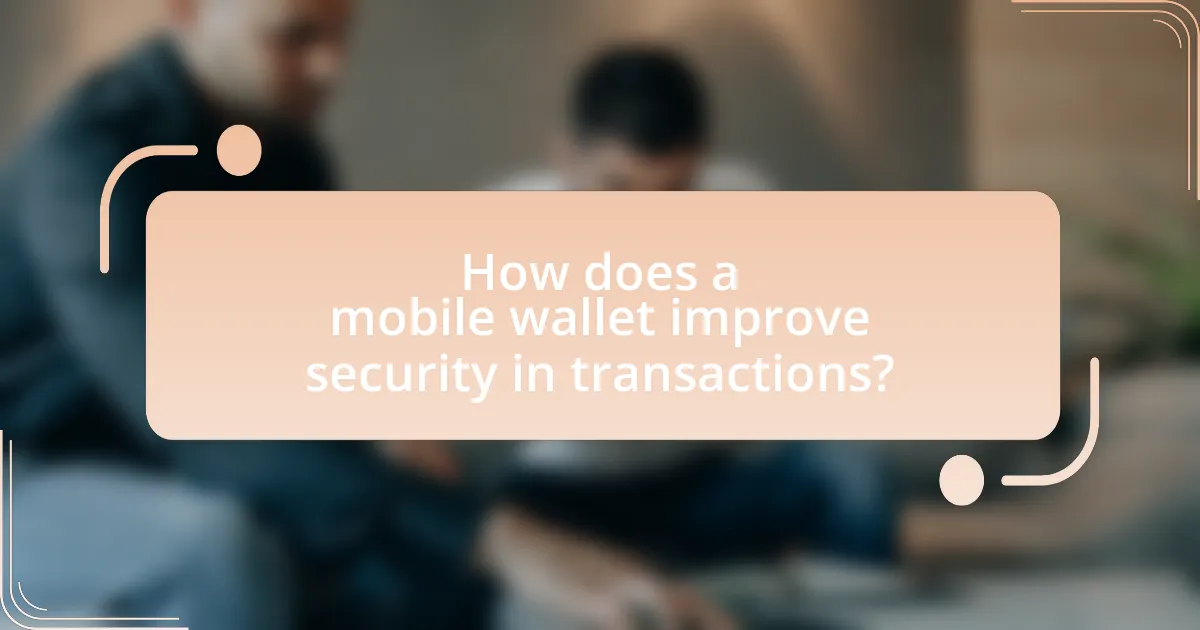A mobile wallet is a digital application that enables users to store and manage their financial information, facilitating various transactions directly from their smartphones. This article explores the functionality of mobile wallets in everyday transactions, the technologies that support them, and the security measures that protect users. It also examines the different types of mobile wallets, their advantages over traditional wallets, and how they can enhance budgeting and spending habits. Key benefits include convenience, security, and potential cost savings, making mobile wallets an increasingly popular choice for consumers in the digital payment landscape.

What is a Mobile Wallet?
A mobile wallet is a digital application that allows users to store, manage, and make transactions using their financial information, such as credit and debit card details, directly from their smartphones. Mobile wallets facilitate various payment methods, including contactless payments, online purchases, and peer-to-peer transfers, enhancing convenience and security for users. According to a report by Statista, the global mobile wallet market is projected to reach over $7 trillion by 2025, indicating a significant shift towards digital payment solutions.
How does a mobile wallet function in everyday transactions?
A mobile wallet functions in everyday transactions by allowing users to store payment information securely on their smartphones and make purchases through contactless technology or online platforms. This process typically involves linking a bank account or credit card to the mobile wallet app, enabling users to pay at retail locations by tapping their phone on a compatible point-of-sale terminal or by entering their payment details for online shopping. According to a report by Statista, the global mobile payment market is projected to reach $12.06 trillion by 2027, highlighting the increasing adoption of mobile wallets for convenience and security in transactions.
What technologies enable mobile wallet transactions?
Mobile wallet transactions are enabled by technologies such as Near Field Communication (NFC), QR codes, and secure element technology. NFC allows for contactless payments by enabling devices to communicate wirelessly over short distances, facilitating quick transactions at point-of-sale terminals. QR codes provide a visual method for users to make payments by scanning a code with their mobile device, which can link to payment information securely. Secure element technology ensures that sensitive data, such as payment credentials, is stored safely within the device, protecting against unauthorized access. These technologies collectively enhance the convenience and security of mobile wallet transactions, making them a popular choice for everyday payments.
How do security measures protect mobile wallet users?
Security measures protect mobile wallet users by implementing encryption, authentication, and fraud detection technologies. Encryption secures sensitive data, making it unreadable to unauthorized parties, while authentication methods, such as biometrics or two-factor authentication, ensure that only the legitimate user can access the wallet. Additionally, fraud detection systems monitor transactions for unusual activity, alerting users and preventing unauthorized transactions. According to a report by the Federal Trade Commission, mobile wallets that utilize these security measures significantly reduce the risk of fraud, enhancing user confidence and safety in digital transactions.
What types of mobile wallets are available?
There are several types of mobile wallets available, including digital wallets, cryptocurrency wallets, and bank-linked wallets. Digital wallets, such as Apple Pay and Google Pay, allow users to store payment information and make transactions using their smartphones. Cryptocurrency wallets, like Coinbase and Binance, enable users to store and manage digital currencies securely. Bank-linked wallets, such as Venmo and Zelle, facilitate peer-to-peer transactions directly linked to users’ bank accounts. Each type of mobile wallet serves distinct purposes, catering to various user needs in the digital payment landscape.
What are the differences between digital wallets and traditional wallets?
Digital wallets and traditional wallets differ primarily in their form and functionality. Digital wallets store payment information electronically, allowing users to make transactions via smartphones or computers, while traditional wallets physically hold cash, cards, and identification. Digital wallets offer convenience through features like contactless payments and online shopping, whereas traditional wallets require physical handling of cash and cards. Additionally, digital wallets often incorporate security measures such as encryption and biometric authentication, which are not applicable to traditional wallets. According to a report by Statista, the global digital wallet market is projected to reach $7.6 trillion by 2024, highlighting the growing preference for digital transactions over cash-based methods.
How do peer-to-peer payment apps fit into the mobile wallet category?
Peer-to-peer payment apps are integral to the mobile wallet category as they facilitate direct money transfers between individuals using mobile devices. These apps, such as Venmo and Cash App, allow users to send and receive funds instantly, making transactions seamless and convenient. According to a 2021 report by Statista, the global mobile payment market is projected to reach $12.06 trillion by 2026, highlighting the growing importance of mobile wallets, which include peer-to-peer payment functionalities. This integration enhances the overall utility of mobile wallets, enabling users to manage various financial transactions in one platform.

What are the key benefits of using a mobile wallet?
The key benefits of using a mobile wallet include convenience, enhanced security, and faster transactions. Mobile wallets allow users to store multiple payment methods in one place, making it easy to pay without carrying physical cards or cash. Enhanced security features, such as encryption and biometric authentication, protect users’ financial information. Additionally, mobile wallets facilitate quicker transactions, reducing wait times at checkout, which is supported by a study from the Federal Reserve that found mobile payments can be processed in seconds compared to traditional methods.
How does a mobile wallet enhance convenience for users?
A mobile wallet enhances convenience for users by allowing them to store multiple payment methods and access them instantly on their smartphones. This eliminates the need to carry physical cards or cash, streamlining the payment process. For instance, a study by Statista in 2021 indicated that 45% of consumers prefer mobile wallets for their speed and ease of use during transactions. Additionally, mobile wallets often integrate features like transaction history, loyalty programs, and promotional offers, further simplifying the shopping experience.
What features contribute to the ease of use in mobile wallets?
Mobile wallets are designed with several features that enhance their ease of use, including user-friendly interfaces, quick transaction capabilities, and secure authentication methods. User-friendly interfaces simplify navigation, allowing users to easily access their payment options and transaction history. Quick transaction capabilities enable users to complete payments swiftly, often through contactless technology, which reduces wait times at checkout. Secure authentication methods, such as biometric recognition or PIN codes, provide a balance of convenience and security, ensuring that users can access their wallets quickly while protecting their financial information. These features collectively contribute to a seamless user experience, making mobile wallets a preferred choice for everyday transactions.
How does a mobile wallet streamline the payment process?
A mobile wallet streamlines the payment process by enabling quick and convenient transactions through digital means. This technology allows users to store payment information securely on their smartphones, facilitating instant payments via near-field communication (NFC) or QR codes. According to a report by Statista, mobile wallet usage is projected to reach 1.31 billion users globally by 2023, highlighting its growing acceptance and efficiency in everyday transactions. By reducing the need for physical cash or cards, mobile wallets minimize transaction times and enhance user experience, making payments faster and more efficient.
What financial advantages does a mobile wallet provide?
A mobile wallet provides several financial advantages, including convenience, reduced transaction costs, and enhanced budgeting capabilities. Users can make quick payments without needing cash or cards, streamlining the purchasing process. Additionally, many mobile wallets offer lower fees for transactions compared to traditional banking methods, which can save users money over time. Furthermore, mobile wallets often include budgeting tools that help users track their spending and manage their finances more effectively, promoting better financial health.
How can users save money through discounts and rewards?
Users can save money through discounts and rewards by utilizing mobile wallets that offer cashback, promotional discounts, and loyalty points. Mobile wallets often partner with retailers to provide exclusive offers, allowing users to receive immediate savings at checkout. For instance, a study by the National Retail Federation found that 75% of consumers are more likely to use a mobile wallet if it offers rewards or discounts, demonstrating the effectiveness of these incentives in encouraging spending while saving money.
What are the potential cost savings compared to traditional banking methods?
Mobile wallets can offer significant cost savings compared to traditional banking methods, primarily through reduced transaction fees and lower overhead costs. For instance, mobile wallets often charge minimal or no fees for transactions, while traditional banks may impose fees for wire transfers, account maintenance, and ATM usage. According to a report by the Federal Reserve, mobile payment systems can reduce transaction costs by up to 2% per transaction compared to credit card processing fees, which typically range from 2% to 3%. Additionally, mobile wallets eliminate the need for physical infrastructure, leading to lower operational costs for service providers, which can be passed on to consumers in the form of savings.

How does a mobile wallet improve security in transactions?
A mobile wallet improves security in transactions by utilizing advanced encryption and tokenization technologies. These technologies protect sensitive information, such as credit card numbers, by converting them into unique tokens that are useless if intercepted. For instance, a study by the Federal Reserve indicates that mobile wallets can reduce fraud risk by up to 50% compared to traditional payment methods. Additionally, mobile wallets often require biometric authentication, such as fingerprint or facial recognition, adding an extra layer of security that is not present in physical cards. This combination of encryption, tokenization, and biometric verification significantly enhances transaction security.
What security features are commonly found in mobile wallets?
Mobile wallets commonly incorporate security features such as encryption, biometric authentication, and tokenization. Encryption protects sensitive data by converting it into a secure format that can only be read by authorized parties. Biometric authentication, including fingerprint or facial recognition, ensures that only the authorized user can access the wallet. Tokenization replaces sensitive card information with a unique identifier or token, minimizing the risk of fraud during transactions. These features collectively enhance the security of mobile wallets, making them a safer option for everyday transactions.
How does encryption protect user data in mobile wallets?
Encryption protects user data in mobile wallets by converting sensitive information into a coded format that is unreadable without the appropriate decryption key. This process ensures that even if data is intercepted during transmission or accessed by unauthorized parties, it remains secure and confidential. For instance, mobile wallets often use advanced encryption standards, such as AES-256, which is widely recognized for its strength and effectiveness in safeguarding data. By employing encryption, mobile wallets significantly reduce the risk of data breaches and fraud, thereby enhancing user trust and security in digital transactions.
What role does biometric authentication play in mobile wallet security?
Biometric authentication significantly enhances mobile wallet security by providing a unique and personal method of verifying user identity. This technology utilizes physical characteristics, such as fingerprints or facial recognition, which are difficult to replicate or steal compared to traditional passwords or PINs. According to a study by the National Institute of Standards and Technology, biometric systems can reduce the risk of unauthorized access, as they rely on traits that are inherently tied to the individual. This makes mobile wallets more secure against fraud and identity theft, thereby increasing user confidence in digital transactions.
How does using a mobile wallet impact budgeting and spending habits?
Using a mobile wallet positively impacts budgeting and spending habits by providing users with real-time tracking of their transactions. This immediate visibility allows individuals to monitor their spending patterns closely, leading to more informed financial decisions. According to a study by the Federal Reserve, 60% of mobile wallet users reported improved budgeting capabilities due to the ability to categorize and analyze their expenses directly within the app. Additionally, mobile wallets often include features such as spending alerts and budget-setting tools, which further enhance users’ ability to manage their finances effectively.
What tools do mobile wallets offer for tracking expenses?
Mobile wallets offer various tools for tracking expenses, including transaction history, budgeting features, and spending categorization. Transaction history allows users to view all past transactions, providing a clear overview of spending patterns. Budgeting features enable users to set spending limits for different categories, helping them manage their finances effectively. Additionally, spending categorization organizes transactions into predefined categories, making it easier for users to analyze their spending habits. These tools collectively enhance financial awareness and assist users in making informed financial decisions.
How can mobile wallets help users stick to their budgets?
Mobile wallets help users stick to their budgets by providing real-time tracking of spending and categorizing transactions. This immediate visibility allows users to monitor their expenses against their budget limits, facilitating informed financial decisions. According to a study by the Federal Reserve, 60% of mobile wallet users reported improved budgeting capabilities due to the instant feedback on their spending habits. Additionally, many mobile wallets offer features like spending alerts and budget-setting tools, which further assist users in maintaining financial discipline.
What are the best practices for using a mobile wallet effectively?
To use a mobile wallet effectively, users should enable two-factor authentication to enhance security. This practice significantly reduces the risk of unauthorized access, as it requires a second form of verification beyond just a password. Additionally, users should regularly update their mobile wallet app to benefit from the latest security features and bug fixes, which are crucial for protecting sensitive financial information. According to a report by the Federal Trade Commission, mobile payment fraud has increased, highlighting the importance of these security measures. Furthermore, users should monitor their transaction history frequently to identify any unauthorized transactions promptly, ensuring that any discrepancies can be addressed quickly.
How can users ensure their mobile wallet remains secure?
Users can ensure their mobile wallet remains secure by implementing strong security measures such as enabling two-factor authentication, using biometric locks, and regularly updating their software. Two-factor authentication adds an extra layer of protection by requiring a second form of verification, which significantly reduces the risk of unauthorized access. Biometric locks, such as fingerprint or facial recognition, provide a secure and convenient way to access the wallet. Regular software updates are crucial as they often include security patches that protect against vulnerabilities. According to a study by the Federal Trade Commission, using two-factor authentication can reduce the risk of account compromise by up to 99%.
What tips can help users maximize the benefits of their mobile wallet?
To maximize the benefits of a mobile wallet, users should regularly update their app to access the latest features and security enhancements. Keeping the app updated ensures that users benefit from improved functionalities, such as faster transactions and enhanced security measures, which are crucial for protecting sensitive financial information. Additionally, users should link their mobile wallet to loyalty programs and rewards cards, as this integration allows them to earn points or cashback on purchases, effectively increasing savings. Research indicates that consumers can save an average of 5% on purchases through loyalty rewards, making this a practical strategy for maximizing wallet benefits. Lastly, users should familiarize themselves with all available features, such as budgeting tools and transaction history, to better manage their finances and optimize spending.